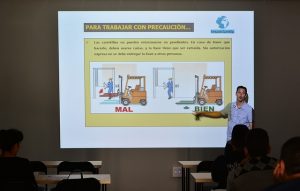 Non-English speaking employees may fall victim to injuries and fatalities because they do not understand the proper safety protocol. These employees face a communication barrier daily. In this post, we will explore the impact that the language barrier has on the safety industry. We will share some ways to break through language barriers in the safety industry and improve injury rates among non-English speaking employees.
Non-English speaking employees may fall victim to injuries and fatalities because they do not understand the proper safety protocol. These employees face a communication barrier daily. In this post, we will explore the impact that the language barrier has on the safety industry. We will share some ways to break through language barriers in the safety industry and improve injury rates among non-English speaking employees.
Training
An effective safety program starts with training. An employer must outline the safety and health risks of the employment and develop a safety program to eliminate, reduce, and/or control the risks. Training educates employees on the safety practices needed for their jobs. The safety training conducted is usually measured through work practices or testing. In order to become proficient in the safety subject matter, the employee must be able to understand what is being taught. Employees who do not speak English are unable to comprehend the safety training. Therefore, the non-English speaking workers are at higher risk for injury or illness. KEMI is equipped with a bilingual department that can attend KEMI-led safety trainings and assist with translation.
Injury Rates
Injury rate statistics prove the language barrier is real and affecting our non-English speaking employees exponentially. Injury rates for non-English speaking workers are much higher, and these employees may not understand the risks they face daily. These employees may also lack the safety background or education received through training if it was only taught in English.
Daily Work
 On a daily basis, many employees have the opportunity to work together and learn from one another, however non-English speaking workers may not benefit in the same way if a language barrier exists. The usual work meetings or tool box talks are not helpful if some workers cannot understand what is being communicated. To help remedy this issue, keep in mind that some employees who use English as a second language may be familiar with what is being said and can relay the message to the others. Having a buddy system like this allows the non-English speaking employees to have someone they can depend on and communicate with.
On a daily basis, many employees have the opportunity to work together and learn from one another, however non-English speaking workers may not benefit in the same way if a language barrier exists. The usual work meetings or tool box talks are not helpful if some workers cannot understand what is being communicated. To help remedy this issue, keep in mind that some employees who use English as a second language may be familiar with what is being said and can relay the message to the others. Having a buddy system like this allows the non-English speaking employees to have someone they can depend on and communicate with.
Speaking versus Reading
Some employees who use English as a second language may be able to roughly speak and understand it. We cannot assume that, just because these employees can speak and understand English, they can also read it. If the employee is unable to read English, other types of communication should be developed (this not only applies to non-English speaking employees but also those employees who may be illiterate). Symbols and pictures may be useful for employees’ recognition.
Temporary versus Long Term Employees
Research demonstrates that temporary workers are at increased risk of workplace injury. Statistics show that temporary workers have double the risk of suffering severe injuries on the job. Employers know that temporary employees are not going to be working long, however that should not have an impact on the employers’ desire to keep the workers safe.
Translation
OSHA is developing training materials available in multiple languages. Employers with employees who do not speak English should consider translating their policies, procedures, and signs into the particular language the employee needs. This step would make it easier for employees to read the training material and learn the best safety practices. These steps will go a long way in helping non-English speaking employees improve their safety knowledge.
Did you know that KEMI can be used as a resource for Spanish materials? Email safety@kemi.com to learn more.
Interpreters & Bilingual Employees
Employers may also consider hiring an interpreter for bilingual employees. These employees may serve as a liaison for employees who do not speak English. They may also help in conduct training and pair up with non-English speaking employees to ensure they understand safety requirement and training. The bilingual employee may also interpret questions or concerns of the non-English speaking employee. There may be a costly initial investment in hiring an interpreter, but the return on that investment may pay dividends. The more education the employees receive on workplace safety, the less likely they are to get injured.
Hands on Training
Another way to work through a language barrier is to provide one-on-one, on the job training. The explanation of safety accompanied with hands-on experience may help the employee’s understanding of how to avoid an accident or injury.
English Classes
Employers may consider offering English classes for non-English speaking employees to help them better understand safety procedures, tools, machines, and much more. Investing in employees will help them develop into better workers, and this may help the employee not only at work but in the community.
Overall Return on Investment
The number of workers who use English as a second language is increasing rapidly. Employers should take steps to develop a safety training program for non-English speaking workers, and should maintain an environment where these employees feel accommodated. As communication improves, the risk of injuries decreases. Overcoming the language barrier will take time, effort, and financial investment, but in the end it will improve the work environment and help keep safety at the forefront.
KEMI does not assume liability for the content of information contained herein. Safety and health remain your responsibility. This information is to be used for informational purposes only and not intended to be exhaustive or a substitute for proper training, supervision or manufacturers’ instructions/recommendations. KEMI, by publication of this information, does not assume liability for damage or injury arising from reliance upon it. Compliance with this information is not a guarantee or warranty that you will be in conformity with any laws or regulations nor does it ensure the absolute safety of any person, place or object, including, but not limited to, you, your occupation, employees, customers or place of business.

